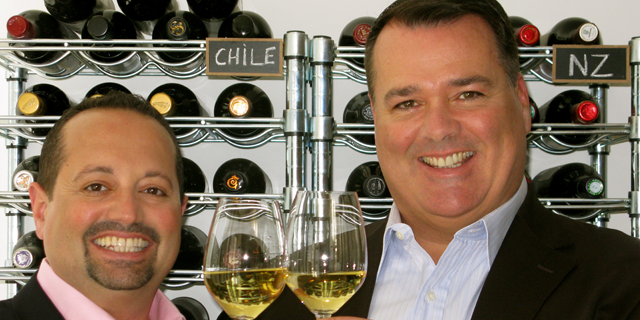Mike DeSimone and Jeff Jenssen are eating, drinking, and writing their way across the globe as the World Wide Wine Guys and entertaining and lifestyle editors for Wine Enthusiast magazine. Their latest book, Wines of the Southern Hemisphere: The Complete Guide (Sterling Epicure) was recently released, just in time for the holiday season. They took a breather from their travels to speak to The Latin Kitchen about the new ground they’re covering:
TLK: How did you start working together?
Mike: We were always traveling together to wine regions, and it became logical for us to write about travel, wine and food.
TLK: What first drew you to the wines of the Southern Hemisphere?
Jeff: Being able to speak Spanish and traveling to Argentina, Chile, Brazil, and Uruguay really gave us a love of the country, a love of the culture, a love of the wine, and a love of the food.
TLK: In the book, you write that South American wine exports to the United States have increased from 3 to 27% in just under 20 years, and Argentinian and Chilean imports are on pace to surpass France. Is there a reason the tide turned?
Jeff: The wines from the Southern Hemisphere are well made — with winemakers at these wineries hailing from Spain, France, and Italy — and were undervalued. We saw that the market had these really great wines, at really cheap, reasonable prices. The increase in the euro versus the dollar and decrease in currencies in South America made those wines much more attractive. It was people walking into wine shops and seeing a wonderful Bordeaux wine from France that might be $30 and a Bordeaux-style wine from Argentina, Chile or even South Africa that might be $10. The economic recession played into people getting into wines from the Southern Hemisphere.
TLK: There was a great deal of trial and error introducing Old World grape varieties to the region. Has this experimentation created new possibilities in wine making?
Jeff: One word – Malbec. Malbec is probably the most popular grape grown in Argentina. It’s originally from a place in southwest France called Cahors, just south of Bordeaux. While Bordeaux is known for Cabernet Sauvignon and Merlot, Cahors was known for Malbec used as a blending grape. In Argentina, they found that the climate and the soil did well for the propagation of Malbec vines. Malbec in now the #1 export from Argentina. It was a little used, overlooked grape in France, now it’s a star in the Southern Hemisphere.
Mike: Carmenere is also a grape used in very small amounts for blending in France. Because of the soil and climate in Chile, it has done very well, and we’re seeing really high quality, single varietal Carmeneres coming out of Chile. I don’t want to say never, but you rarely see Carmenere from France, it’s always a blending grape.
TLK: The Chilean micro-climate you describe has a slew of natural advantages. Is the wine industry in the Southern Hemisphere more adaptable to eco-friendly practices?
Jeff: Chile is one of the most beautiful, unpolluted countries. It’s a very thin strip of land where north to south, you’re never more than 1 or 2 hours from the ocean. It benefits from cool ocean breezes and cooler climate as you go into the altitude of the Andes. Chile doesn’t have the phylloxera [microscopic insects], molds, or wet weather diseases that can effect the grapes and vines. It’s easier to be organic there because that’s how they’ve always grown their grapes. They don’t need to spray them for molds, funguses, and pests. They have a total advantage over many European countries. Many people are turning to these wines because they are bio-dynamic and organic. I’d rather drink wine without preservatives. I think we all would.
TLK: What are the up and coming wine producing countries?
Jeff: Brazil is a country to be watched right now. A major importer, Southern Wine, is starting to bring Brazilian wines into this country in January. The Brazilian sparkling wines – whether they’re champagne method, Pinot Noir, Chardonnay or Muscato – are wonderful. I think we’re going to see a big influx of those into the market. They’re very well priced, they’re well made, and they’re great value.
TLK: Are chefs turning to these wines more frequently?
Jeff: We teach a class called Windows on the World: The Wines of the Southern Hemisphere in cooperation with Kevin Zraly at Sherry-Lehman. We were showing this one wine – Le Dix de los Vascos – that’s made by the Rothschild family. It’s a $50 wine that’s superb and excellent. The pedigree is Rothschild but, if this was a Lafite-Rothschild, it would be $600. The value is there, so a many chefs are pairing some wonderful cuisine with these wonderful wines, absolutely.
TLK: Now that we’re going into the holiday season, are there any wines you can suggest for gifts?
Mike: One of my favorites is from Miguel Torres which was founded in Spain and is now in Chile. They make something called Santa Digna Estelado Rose which is a sparkling wine made from the País or Mission grape which the conquistadors and sailors brought over from Spain. It’s festive and good for the holidays. At $25 a bottle, it’s a terrific gift and great wine to open any meal. You can also check out our Holiday Wine Guide for TLK here.


![Making Mealtime Matter with La Familia: Easy Sofrito [Video]](https://thelatinkitchen.com/wp-content/uploads/2015/10/sofrito-shutterstock__0-500x383.jpg)
![Easy Latin Smoothies: Goji Berry Smoothie [Video]](https://thelatinkitchen.com/wp-content/uploads/2015/12/goji_berry-shutterstock_-500x383.jpg)
















![Fun and Fast Recipes: Fiesta Cabbage Salad [Video]](https://thelatinkitchen.com/wp-content/uploads/2015/11/fiesta_cabbage_slaw-shutterstock_-500x383.jpg)









